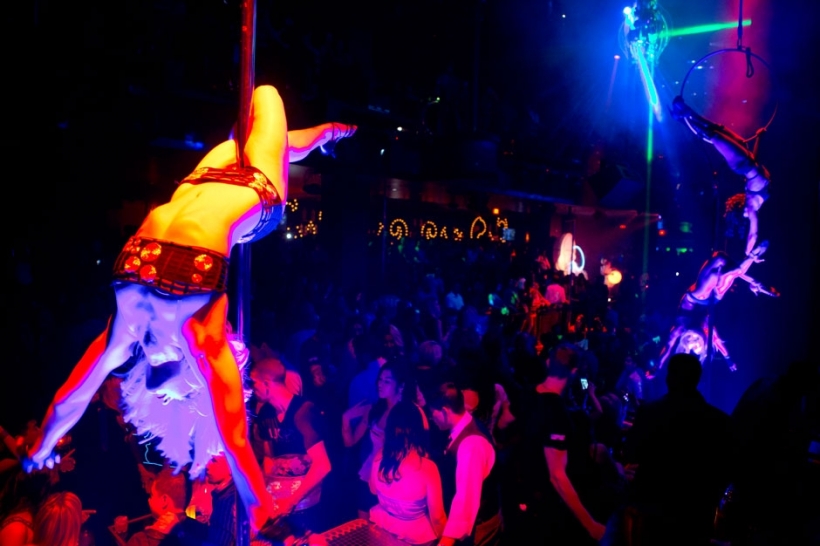Nightclubs come in all shapes and sizes, but stepping into what's considered a "performance" style nightlife venue today is a unique experience. Walking through the entrance is similar to falling down the rabbit hole, and that's exactly what's expected by patrons. For them, it's all about leaving their everyday gripes at the door, and indulging in a high-energy experience that's out of the norm.
While the days of Studio 54 and Limelight offered ocular journeys that were unlike anything else at the time, today's colossal performance nightclubs are equipped with the technology and cash flow to change the flavor of the space from one night to the next.

Cirque du Soleil aerial performers at Light Nightclub inside Mandalay Bay Hotel & Casino in Las Vegas. Photo by Leila Navid.
Destinations like LIV and Story in Miami, Light and Marquee in Vegas, and Pacha in New York City are unique establishments that put on a show for you, from the dancers and lighting to that special guest in the booth.
Those new to the industry may think that venues like these unprecedented, but in reality they are spawned by the aforementioned party palaces that reigned in the 70s, 80s, and 90s. Just like any other industry, certain aspects of nightlife come in waves - we just happen to be in a thick seismic swell that is the resurgence of performance nightclubs.
"Nightclubs have always existed, but they never had the attention that they have now," says Carlos Correal, music director at Insomniac Events. "Now people from across the world go to a place like Las Vegas just to visit a nightclub."
With 20 years of experience in nightlife and event management, including a major stint at the Opium Group in Miami, Correal has been there and done that. When it comes to piecing together the pieces of a puzzle to create an unforgettable musical event, be it at a club or concert locale, it's his expertise you seek.
While he has experienced the evolution of the nightlife business firsthand, he believes that there aren't necessarily more clubs, just bigger ones that are getting attention because of the clientele they bring in.
"VIP tables were introduced anywhere from 10 to 15 years ago, a trend that was started in places like St. Tropez and made its way to Miami," Correal says. "There are a lot of very rich and notable people that visit those clubs and that's why they get the mainstream attention they do now."
According to Nightclub & Bar's Top 100 list of the nation's highest grossing nightclubs, Vegas nightlife landmarks XS and Marquee came in on top with an estimated $80-$90 million in revenue in 2012. Sales like that allow these clubs to provide its guests with awe-inspiring features like state-of-the-art lighting and sound, which Correal says makes up 50 percent of the experience, in addition to what he thinks is the focal point of the venue - the DJ.
"Nightclubs that have relied their business solely on DJs have a big problem because it's extremely competitive," he says. "It's a business all driven by who has the bigger talent."
While that may be a challenge, he says that there are key steps one should take if they're interested in getting into the aggressive business - having the right partners and venue is crucial.
"There will always be these [performance] venues that serve a demand," he says. "So long as that's around these mega-nightclubs with performers will keep innovating to stay competitive with technology and try to keep the cost of operation as low as possible to increase their profit margin year over year."